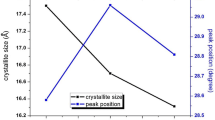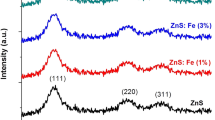Abstract
Zn0.98−xNixMn0.02S (x = 0, 0.02, 0.04) quantum dots have been synthesized by using simple co-precipitation method. The synthesized samples were characterized using various analytical tools to monitor optimum properties. X-ray diffraction analysis revealed that the materials had cubic crystal structure as well as phase purity. The average crystallite size was determined within the range of 1.3 to 1.8 nm using Debye Scherer equation. The microscopic studies showed the smooth surface passivation and agglomeration of particles. Energy Dispersive X-ray analysis ensured the existence of compositional elements, Zn, Ni, Mn and S in the synthesized samples within the stoichiometry ratio. UV–Visible absorption and transmittance studies and band gap estimation were taken from optical studies. The optical studies showed the red shift in absorption and elevation of intensity by increasing Ni concentration. The band gap of the samples was found to be in the range of 3.56–3.93 eV (red shift) because of the exchange interactions between Zn (3d10) and localized d electrons of Mn (3d5) and Ni (3d8). From the observation of linear red shift of band gap, substantial absorption and low transmittance by Ni incorporation, this material can be chosen as a suitable applicant for the optoelectronic device applications and as a buffer material for the solar cell applications. FTIR spectrum report confirmed the presence of the dopant into the ZnS host lattice and chemical bonding corresponding to each elements in the prepared samples.







Similar content being viewed by others
References
A.P. Alivisatos, Science 271, 933 (1996)
A.M. Smith, S. Nie, Analyst 129, 672 (2004)
M. Bruchez, M. Moronne, P. Gin, S. Weiss, A.P. Alivisatos, Science 281, 2013 (1998)
B. Shen, H. Zhou, Z. Chen, Z. Wang, Y. Sheng, J. Chen, B. Geng, J. Nanosci. Nanotech. 12, 3931 (2012)
I. Gerdova, A. Hache, Optics Commun. 246, 205 (2005)
F. Deng, X. Mei, J. Mater. Sci. Mater. Electron 26, 7635 (2015)
J. Wang, Y. Li, Q. Shen, T. Izuishi, Z. Pan, K. Zhao, X. Zhong, J. Mater. Chem. A 4, 877 (2016)
S. Ummartyotin, Y. Infahsaeng, Renew. Sustainable Energy Rev. 55, 17–24 (2016)
R.N. Bhargava, D. Gallagher, X. Hong, A. Nurmikko, Phys. Rev. Lett. 72, 416 (1994)
P. Sakthivel, S. Muthukumaran, M. Ashokkumar, J. Mater. Sci. Mater. Electron 26, 1533 (2015)
H.V. Bui, H.N. Nguyen, IEEE Trans. Magn. 50, 1 (2014)
V. Ramasamy, K. Pabha, G. Murugadoss, Superlattices Microstruct. 51, 699 (2012)
R. Sanjeevkumar, V. Veeravazhuthi, N. Muthukumarasamy, M. Thambidurai, D. Vishnushankar, Superlattices Microstruct. 86, 552 (2015)
S. Darafarin, R. Sahraei, A. Daneshfar, J. Alloys Compd. 658, 780 (2016)
M. Molaei, F. Karimimaskon, A. Lotfiani, M. Samadpour, H. Liu, J. Lumin. 143, 649 (2013)
HQ Xie, LJ Tang, JL Tang, P Peng, J. Magn. Magn. Mater. 377, 239 (2015)
G. Murugadoss, J. Lumin. 132, 2043 (2012)
B. Poornapraksah, S. Sambasivam, D.A. Reddy, G. Murali, R.P. Vijayalakshmi, B.K. Reddy, Ceram. Int. 40, 2677 (2014)
H. Chen, D. Shi, J. Qi, J. Appl. Phys. 109, 084338 (2011)
J.K. Saleem, T.M. Hameed, S. Kuhn, I. Nahal, M.A. Draaz, N.K. HeJazy, R. Hempelmann, J. Mater. Sci. Mater. Electron 25, 5188 (2014)
P. Sakthivel, S. Muthukumaran J. Inorg. Organomet. Polym. 26, 563 (2016)
V. Ramasamy, K. Prabha, G. Murugadoss, Spectrochem. Acta Part A 96, 963 (2012)
P. Yang, M. Lu, D. Xu, D. Yuan, C. Song, S. Liu, X. Cheng, Opt. Mater. 24, 497 (2003)
J. Kaur, M. Sharma, O.P. Pandey, Opt. Mater. 47, 7 (2015)
N.R. Pavaskar, C.A. Menezes, A.B.P. Sinha, J. Elctrochem. Soc. 124, 743 (1977)
B.S. Ramadevi, R. Raveendran, A.V. Vaidyan, Pramana J. Phys. 68, 679 (2007)
Author information
Authors and Affiliations
Corresponding author
Rights and permissions
About this article
Cite this article
Sakthivel, P., Muthukumaran, S. Investigation of Ni influence on structural and band gap tuning of Zn0.98Mn0.02S quantum dots by co-precipitation method. J Mater Sci: Mater Electron 28, 8309–8315 (2017). https://doi.org/10.1007/s10854-017-6545-y
Received:
Accepted:
Published:
Issue Date:
DOI: https://doi.org/10.1007/s10854-017-6545-y




